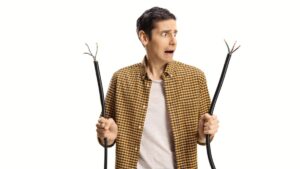Inventory is the mother of necessity: Nike lifts Q3 revenue, loses China, totally quits kangaroos

Don't look son, he's wearing Nike. Via Getty
Being something of a Dunlop Volley man, I don’t really go in for Nike.
Just Do It may’ve been a landmark for advertising, but its faux wit implied I needed life coaching from a shoe company – when what I really needed was better shoes – and the omnipresence of that clever motto and its obscene prices now precluded that ever happening from Nike or the innumerable pretenders which followed it.
The Volleys work fine.
Anyway. Aside from going on to do it, Nike’s a very interesting company, I’ll give them that.
For example yesterday in the States – March 26 – was otherwise known as Nike Air Max Day. Surely a holiday for the masses.
According to Footwear News, sneaker fiends love a throwback sneaker holiday, ‘the Air Max collection is a lesson in what sneakers do best: blend technological innovation with fashion and Nike brings that energy to Air Max Day.’
Air Maxes have been around since the late ’70s, and with that history comes 35 years of new Air tech and sneaker design.
The Air technology – what we see as the small, clear pocket in the middle – was of course apparently designed by the obligatory NASA genius.
“As legend has it, the former engineer Franklin Rudy brought this bag of pressurised air to Nike, and Nike dropped the first Air sneaker in 1978 at the Honolulu Marathon,” the sneaker fiend bible says.
Turns out the sportswear giant first celebrated its single brand (or ‘franchise’) inspired holiday in 2014 with the release of the original Air Max 1 “in the iconic ‘University Red’ colourway, albeit with a new ‘Volt’ twist and details.”
Since then, Nike’s been pumping out special variations on the same theme centered around Air Max Day.
The marketing is clever and the just-did-its financial results released mid last week in New York surprised on the upside with a strong lift in the outlook for full-year revenue, but with a slightly dampening warning on profit margins.
Nike Earnings
Revenue came in well above expectations despite slow sales out of China, so you’d imagine there were a few Just Did It high fives in sneaker central last week… that was, until Nike (NKE) shares fell in early NY trade the following session.
That’s because sometimes good numbers don’t eclipse being the Dow Jones’ go-to bellwether stock – as the sportswear giant is – for a global consumer economy that looks uncertainly humdrum.
Nike earnings (EPS) fell 9% year on year (YoY) to 79 cents a share, a better-than-forecast result despite taking Q3 net income from US$1.40bn to US$1.24 billion.
Revenue meanwhile, jumped 14% to US$12.39bn, also double what-they-expected. Wall Street (Factset) expected Nike to post a 36% EPS decline YoY, to 56 cents. Revenue was expected to be circa 6% to US$11.482 billion.
Direct sales, driven by the largely North American foot-fetishists, rose 17% to US$5.3 billion.
But back to Air Max Day… as part of the celebration, Nike School: Chicago (NS:C) is creating the Air Council.
Pretty good name, Air Council.
Anyway, it’s ‘a program that explores what innovation means.’
‘The aim of the program is to foster the next generation of creative thinkers by connecting them with Chicago’s creative elite, who are leaders in the industries of film, design, communication, community, and fashion. Participants will be coached through a curated six-week program involving learning experiences such as portfolio reviews, real-world adaptations, design challenges, and networking opportunities.’
Nike takeaways
Problem here for Nike was – and has been – margin pressures which are uncomfortably tight for a shoe maker. Nike says it is persisting with the way forward which is trying to burn through backed up excess inventory by offering bargain discounts.
So revenue rose and net income fell during the third quarter of fiscal 2023, with strong demand for Nike’s Jordan Retro and newer ‘franchise’ launches such as LeBron 20.
Just the fact they’re calling a new shoe a franchise indicates pretty clearly how incredibly successful these things are and how they’ve helped Nike grow its market share, while the bugbear of excess apparel inventory has began to decline.
Because while these franchises might be going cheap in retail, there’s an intrinsic product value thing going on elsewhere that makes Nike immune to any cheapening of the brand.
The Wall Street Journal reports that the auction house Sothebys is about to flog 6 Nike Air Jordans that the Michael Jordan wore during the 6 NBA championship games won by the Chicago Bulls in the 1990s.
And I’m talking shoes – not – pairs.
Apparently it’s a collection so coveted by the sneaker fiend collective that even Sotheby’s isn’t bothering to hazard a guess as to what one of these things could go for.
One nutty collector says the minimum bid will be US$20 million and the collection could fetch as much as US$100 million.
It’s a brand notoriety which belies the heavy investment in superlatively low-cost manufacturing which it achieved by virtually inventing both outsourcing and sweat shops and then combining them into almost every aspect of the product manufacturing line and into desperately unregulated countries which, let’s say, have a more favourable wage structure. Moving through emerging economics at their most vulnerable from China, the Philippines, Vietnam, Indonesia, Taiwan and thusly.
Nike CEO
CEO Matt Friend says he expects to end fiscal 2023 with “healthy” inventory levels.
The business saw revenues pop by about 14%, year over year, to US$12.39 billion. The company reported US$10.87 billion in revenue for the same three-month period last year.
Friend was effusive as ever prepared remarks, getting stakeholders on board the upbeat train, headed straight for Positivity, USA.
Friend gushed over Nike’s “tremendous progress on inventory” and said higher margins are a moment away.
Usually costs are low and profit margins are high. That’s been a matter of corse since Nike doesn’t own any of the factories where the Max Airs etc are produced.
Nike’s significantly invested in various innovations and technologies that help reduce labor cost and material costs, but these also count for little when supply lines get dashed and your machine keeps churning out wonder shoes.
Nike around the world
Regionally, Friend said strong holiday sales has kept momentum into the new calendar year across North America, where quarterly revenue rose 27%.
Other regions that saw growth included Europe, the Middle East, Africa, the Asian Pacific and Latin America.
The Greater China region, on the other hand, experienced a single-digit revenue decline.
Something me old mate Josh Gilbert from eToro was less effusive about.
Josh on Nike
“Sales in China remained soft, falling by 7.7% year-over-year. It is going to take a bit of time before Nike sees a return to strong numbers in a key market like China with consumers not spending at pre-pandemic levels and the fairly recent re-opening of the economy.
“Nike shares have had a strong six months gaining more than 25% as consumers continued to spend with its unquestionable brand presence helping them navigate a tricky few years. Although guidance came in slightly soft for the full year, there are plenty of positives for investors, such as falling inventories, solid direct-to-consumer sales, and China’s re-opening.”
Josh added that the inventory thing is still a key focal point for punters as higher levels caused by supply chain disruptions meant Nike had to discount to shift its products, which dented margins.
Roos not shoes
Last week, Nike announced in a statement it will debut a new Tiempo Legend Elite minus any kangaroo – actually a big change for Nike and its headline football boot, confirming it’ll stop making anything with kangaroo bits in 2023.
The pressure got too much for Nike after animal welfare lobbyists – particularly one furious campaign called ‘Kangaroos Are Not Shoes’ run by the US-based Center for a Humane Economy.
That group’s also lobbied US lawmakers to ban the sale of kangaroo products to some success. There are bills before the state legislatures of Oregon, Arizona, Connecticut, Vermont and New Jersey.
This might come as a surprise, but campaigners OS have long been protesting the commercial shooting of roos. EU fashion brands from Chanel to H&M have weaned themselves off kangaroo leather, although how they got stuck on it in the first place must also be a good story.
Animals Australia spokesperson on wildlife Louise Bonomi said this action, following a similar announcement from Puma two weeks ago, means that two of the biggest buyers of kangaroo skins are getting out of the business of financing the largest slaughter of terrestrial wildlife in the world.
She called the news a ‘stark wakeup call’ for the Australian government. The dozy bastards.
“At a time when politicians and corporations on the other side of the world are cutting their ties with the cruel kangaroo slaughter industry — the Australian government is continuing to allow wildlife to be shot and exported by the millions,” Ms Bonomi said.
The move comes weeks after a similar decision from German rival Puma, who got the jump on Nike with both using a proprietary synthetic material which is unlikely to have too many lobby groups worrying about it.
The Nike earnings report also puts a lid on an interminably long reporting season for the Dow Jones Industrial stocks.
UNLOCK INSIGHTS
Discover the untold stories of emerging ASX stocks.
Daily news and expert analysis, it's free to subscribe.
By proceeding, you confirm you understand that we handle personal information in accordance with our Privacy Policy.








